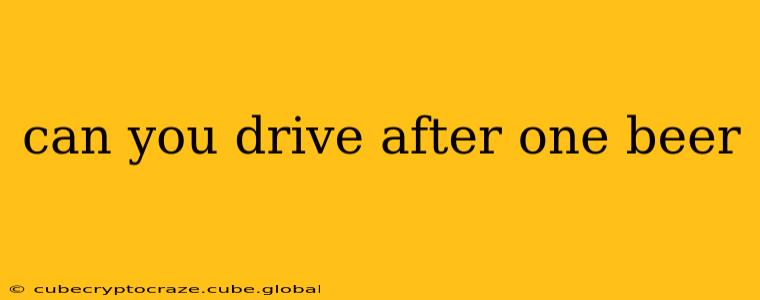Can You Drive After One Beer? The Truth About Impaired Driving
The short answer is: no, you shouldn't drive after one beer. While it might seem like a small amount, even one beer can impair your driving ability, putting yourself and others at risk. The legal limit for blood alcohol content (BAC) varies by location, but it's universally low because the effects of alcohol on driving are significant, even at low levels.
Let's delve deeper into the complexities of driving under the influence, even after seemingly minimal alcohol consumption.
What is the Legal Blood Alcohol Content (BAC) Limit?
The legal BAC limit for driving differs across countries and even states/provinces within a country. There is no universal "one-size-fits-all" answer. In many places, the legal limit is 0.08%, meaning that if your BAC is at or above this level, you are legally considered drunk driving. Some jurisdictions have stricter limits, such as 0.05% or even zero tolerance policies. It's crucial to check the specific laws in your area before consuming any alcohol and planning to drive.
How Does One Beer Affect Driving Ability?
Even a single beer can negatively impact several aspects of your driving:
-
Reaction Time: Alcohol slows your reaction time, making it harder to respond quickly to unexpected situations like sudden braking or a pedestrian stepping into the road. This increased reaction time is one of the most significant dangers of driving under the influence, even at low BAC levels.
-
Coordination and Judgment: Alcohol impairs coordination and judgment, making it difficult to maintain proper lane positioning, accurately judge distances, and make sound driving decisions. Even seemingly minor errors in judgment can have catastrophic consequences.
-
Vision: Alcohol can blur your vision and reduce your ability to perceive depth and distance, further hindering your ability to safely navigate roads and traffic.
-
Risk-Taking Behavior: Alcohol can lower your inhibitions, leading to riskier driving behaviors. You might be more likely to speed, tailgate, or make other unsafe choices behind the wheel.
What Factors Influence BAC?
Your BAC is influenced by several factors beyond simply the number of drinks consumed:
-
Body Weight: Lighter individuals will generally have a higher BAC than heavier individuals after consuming the same amount of alcohol.
-
Gender: Women generally have a higher BAC than men after consuming the same amount of alcohol due to differences in body composition and metabolism.
-
Food Consumption: Eating before or while drinking can slow the absorption of alcohol, resulting in a lower BAC.
-
Type of Alcoholic Beverage: Different alcoholic beverages have varying alcohol content. A standard drink contains roughly 14 grams of pure alcohol.
How Can I Ensure Safe Driving?
The safest course of action is always to avoid drinking and driving altogether. If you plan to consume alcohol, designate a driver, use a ride-sharing service, or take public transportation. There are no exceptions to this rule; prioritizing your safety and the safety of others should always be paramount.
Are there any zero-tolerance policies for driving after drinking?
Yes, many jurisdictions have implemented zero-tolerance policies, particularly for young drivers. These policies mean that any detectable amount of alcohol in your system can lead to penalties, regardless of how little you've had to drink. These policies are designed to discourage underage drinking and driving and promote responsible behavior on the road.
Driving under the influence, even after one beer, is a serious offense with potentially devastating consequences. Protecting yourself and others requires making responsible choices. Never risk it.
